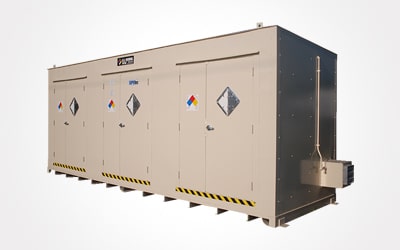Hazardous Waste Storage Buildings – Do You Need One?

Hazardous waste is any waste material that poses a hazard during storage, handling, or disposal. Containers that store this type of waste must be properly maintained, protected, and kept in compliant and approved storage buildings made for the specific risk.
But how do you know if your material is dangerous enough to warrant a special building for its storage?
- Are you a factory, manufacturer, municipal ageny, medical facility, military base, or federal agency?
- Do you work with ignitable materials, corrosives, flammables, toxic material, or reactive materials?
- Does the EPA qualify any chemicals you work with as F-list, K-list, P-list, or U-List?
Hazardous Waste Storage Buildings
A hazardous waste storage building from U.S. Chemical Storage provides a safe and secure location for containers of hazardous waste. It offers the perfect solution for keeping your personnel, investments, and the environment safe from the risks associated with waste materials. The right storage building can help reduce risk exposure by safely storing corrosives, flammables, toxic, and reactive hazardous materials. All our storage buildings are 100% customizable, allowing you the flexibility to create the ideal hazmat storage solution for your specific need. We offer fire-rated or non-fire rated construction to store hazardous wastes nearby or inside your facility within state and federal compliance. A team of professional engineers and experienced, certified welders help make sure our prefabricated buildings are compliant with all state and federal regulations. Our buildings are constructed of high-quality steel for maximum durability and every building features a 15-year structural warranty. Our buildings also come standard with a spill containment sump that is fully tested overnight during manufacturing for quality assurance. Customizable accessories are available, including explosion relief panels, mechanical ventilation, explosion-proof lighting, alarm systems, racks, shelving, liquid level sensors, gas detectors, eyewash stations, and more. You can also add solid partition walls to store incompatible wastes in separate rooms within the same building.Proper Hazardous Waste Storage Best Practices
You should fully understand the waste you’re dealing with before transfer to a storage container. The characterization process should include identifying chemical hazards and properties. Transferring incompatible hazardous wastes within the same storage container increase the possibility of an explosion or fire. If you cannot characterize waste materials, hazards, and/or chemical properties, contact your local environmental office for further guidance on proper handling and storage practices.Tips on Safely Handling and Storing Hazardous Waste
- Understand the risks associated with each hazardous waste you plan to store.
- When transferring hazardous materials, make sure grounding systems are in place.
- Use a funnel to prevent hazardous waste spills (do not use the same funnel for all wastes).
- Keep incompatible wastes in different rooms, separated by solid partition walls.
- Segregate wastes in separate containers (drums, totes, pails, etc.).
- When storing flammable and combustible wastes, make sure to implement explosion-proof or non-explosion proof accessories.
- Certain chemicals can expand with temperature changes, so make sure to store them in a temperature-controlled room.
- Always wear proper protective equipment when transferring or handling hazardous wastes.
- Label hazardous waste containers properly with chemical contents, dates, and DOT labels (contact local officials for labeling requirements).
- Maintain hazardous waste storage by keeping track of inventory dates.
- Do not stack containers inside your hazardous waste building without suitably designed racking.
- Use proper ventilation systems to maintain a safe storage atmosphere.
Hazardous Waste Storage: Common Classifications of Hazardous Materials
Ignitable: Anything that can readily catch on fire during storage, handling, or disposal. Improper storage of ignitable hazardous waste storage is dangerous if particles are allowed to spread over a wide area, threatening the surrounding areas. Toxic: Materials that may release toxins into the atmosphere to pose a substantial hazard to individual health. Exposure may cause permanent injuries, hospitalization, or death. Reactive: These materials tend to react vigorously with other substances, which may include air or water. They must be researched and fully understood before storing with other chemicals. Careful segregation of these materials is paramount. Corrosive: These materials can dissolve other substances – solids or liquids -and can “eat” through their own chemical storage container if stored improperly. *Note: Chemicals aren’t limited to a single classification. Some chemicals contain all four classifications or a combination of multiple classifications. Fully understanding the chemistry of these wastes is necessary to design the proper building for their storage.Understanding Listed Wastes and Their Classifications
The Environmental Protection Agency (EPA) has classified specific hazardous wastes as “listed wastes” because of their potential dangers to human health or the environment. These are classified on the F, K, P or U lists found in title 40 of the Code of Federal Regulations (CFR) in section 261.Listed Waste Categories
F-list wastes: The F-list includes specific solid wastes from particular industrial or manufacturing processes. F-listed wastes are generated from different sectors in the industry. They are commonly known as non-specific source wastes. F-list wastes can be found under 40 CFR (§261.31) regulations. Examples include:- Spent solvent waste
- Electroplating and other metal finishing waste
- Dioxin-bearing waste
- Chlorinated aliphatic hydrocarbons production
- Wood preserving waste
- Petroleum refinery wastewater treatment sludge
- Multisource leachate
- Wood preservation
- Organic chemicals manufacturing
- Pesticides manufacturing
- Petroleum refining
- Veterinary pharmaceuticals manufacturing
- Inorganic pigment manufacturing
- Inorganic chemicals manufacturing
- Explosives manufacturing
- Iron and steel production
- Primary aluminum production
- Secondary lead processing
- Ink formulation
- Coking (processing of coal to produce coke)
